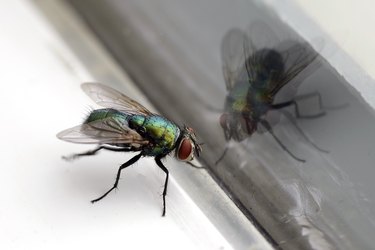
Flies are equal opportunity pests. They don't care whether your garage is a brightly-lit refuge that doubles as a man cave, or if it's a dark and dingy shed that's stuffed with rusty lawn furniture and old mulch: they're happy to move in and make it home. It's pretty common to deal with flies in your garage – not that this is any comfort when you're bracing for a swarm every time you open the door. A few simple tricks should minimize or eliminate the problem.
Reasons for Flies in the Garage
Video of the Day
If you're noticing a lot of fly activity in and around your garage, it's probably because there's something in there that's serving as a food source for these pesky little insects. Once flies have been lured into the space, they can lay eggs and reproduce at an alarming rate. One mature female fly may lay hundreds of eggs in her lifetime, and these hatch in as little as 12 hours. So a major fly infestation can begin with just a few flies sneaking in through an open door or gap in a window frame.
Video of the Day
While there are different types of flies that may infest your garage, they're all generally attracted to anything organic. Rotting food or pet waste in your garbage cans, pet or human food, mulch and decaying leaves are all appealing food sources for flies. These pests may also be attracted to light and warmth, so they may venture into your garage after dark if there's a light on or if it's warmer in the garage than outdoors.
Killing Flies in the Garage
As with other common garage bugs, killing flies in your garage requires a multi-pronged approach. They're stubborn little insects, so it may take using multiple killing methods over several weeks before you notice a significant improvement.
Setting up fly traps is a good starting point. They contain liquid that attracts and then drowns the flies. Buy fly traps from a home improvement store and hang them in the garage, or make your own DIY fly traps using plastic water or soda bottles. Cut off the top of the bottle and fill the bottom with rotting fruit or sugar and water. Add just a little vinegar to keep bees away, and a squirt of dish soap to decrease surface tension and make it harder for flies to escape the water. Put the top half of the bottle on with the mouth facing down and hang the trap. Flies should be lured in by the fruit or sugar and drown.
Sticky fly strips or electrified bug zappers may also work to kill flies and other flying common garage bugs. In addition to traps, you may want to use a fly swatter and/or spray designed for flying insects to immediately kill flies you encounter in the garage. If you have pets or kids around and don't want to spray chemicals, using a DIY fly spray with vinegar and essential oils may stun or repel flies (though it probably won't be effective at killing a large number of these insects).
Preventing Flies in the Garage
A few basic precautions will help you prevent occurrences of flies in the future, and help keep out other common garage bugs. Most importantly, eliminate the food sources that attract flies and other critters. If you keep garbage cans in the garage, make sure their lids are tight-fitting. Clean the insides and outsides of garbage cans with soap and a hose every few weeks to get rid of any old food residue. Move pet food and human food indoors, or put it in sealed storage bins with locking tops.
Sealing gaps in the walls or windows may also make it harder for flies to breach your garage. Replace any worn weather stripping and look for small holes around window and door frames. Try to keep the garage doors closed whenever you're not actively moving in and out of the space.
Finally, use a few different preventative fly repellents in and around your garage. Try planting marigolds or strong-smelling herbs such as lavender, basil or mint near the doors and windows; flies are naturally repelled by these plants. Make a DIY fly repellent spray with vinegar and essential oils, or with cayenne pepper and water. Spray the fly repellent around windows and doorways to keep flies away from these areas.